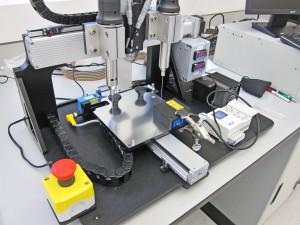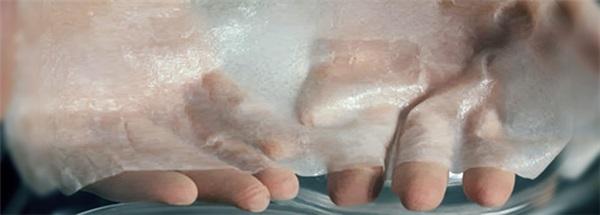 Just as medical applications for standard 3D printing are on the rise, so too are the hopes for usable 3D bioprinted tissue. But 3D printing living tissue is a lore more complex than most people realize, especially when it comes to the complex structures of human organs. Progress has certainly been made, but printing viable tissue is still a tricky process that researchers have yet to crack. While most bioprinting research has typically been focused on medical and organ printing technology, recently cosmetic companies have begun to heavily invest in 3D printed skin in a big way in ever increasing numbers.
Just as medical applications for standard 3D printing are on the rise, so too are the hopes for usable 3D bioprinted tissue. But 3D printing living tissue is a lore more complex than most people realize, especially when it comes to the complex structures of human organs. Progress has certainly been made, but printing viable tissue is still a tricky process that researchers have yet to crack. While most bioprinting research has typically been focused on medical and organ printing technology, recently cosmetic companies have begun to heavily invest in 3D printed skin in a big way in ever increasing numbers.
It started last April when global cosmetics manufacturer L’Oréal teamed up with Organovo to combine their resources to develop 3D bioprinted simulated human skin. The deal includes product exclusivity if the partnership is successful in developing viable tissue. The research will incorporate the NovoGen Bioprinter developed by Organovo and L’Oréal will contribute their own extensive skill cell research and technology. Procter & Gamble jumped into it only a month later by announcing that they were teaming up with the Singaporean government’s Agency for Science, Technology & Research to offer scientists part of a $44 million research program. The focus of the program is on bioprinted skin tissue and developing commercial applications for the technology.
 Things got serious when the world’s largest chemical manufacturer, BASF, announced that they were working with rapidly growing French startup Poietis to test and develop bioactive materials that they can use to test cosmetics and skin care applications. The partnership will include letting Poietis use the BASF-developed Mimeskin material that they’ve already created on their own. Mimeskin is, of course, the closest that anyone has ever gotten to simulating human skin, and further development could mean a breakthrough that the entire cosmetics industry has been waiting for.
Things got serious when the world’s largest chemical manufacturer, BASF, announced that they were working with rapidly growing French startup Poietis to test and develop bioactive materials that they can use to test cosmetics and skin care applications. The partnership will include letting Poietis use the BASF-developed Mimeskin material that they’ve already created on their own. Mimeskin is, of course, the closest that anyone has ever gotten to simulating human skin, and further development could mean a breakthrough that the entire cosmetics industry has been waiting for.
“We are extremely pleased about this collaboration. Having long-term expertise in solutions for the dermocosmetics market, BASF understands the benefits of 3D laser-assisted bioprinting compared to conventional cell culture technologies and other bioprinting methods,” said Founder and President of Poietis Dr Fabien Guillemot.
But despite the promises being made by these new partnerships, bioprinting experts are urging them to be cautious, and warning that 3D printing living tissue isn’t as easy as 3D printing plastic objects.
Arnold Bos at Lux Research warns that cosmetics firms may not be equipped to totally understand the complex biology of human skin. If the researchers working on 3D bioprinted skin don’t take their time they could end up making costly errors, ruin or invalidate all of their research or even provide false or misleading test results.
Skin is a remarkably complicated organ, and is made up of more than just the basic skin cells that most researchers use. There are multiple cellular structures within human skin, so everything from the atmosphere acidity or the temperature can alter the printed skin’s viability and cast doubts on any tested chemicals or cosmetics. Bos suggests that standards for bioprinted skin need to be put in place, and the industry should work closely with industry regulators and medical experts to create a set of 3D bioprinting guidelines that provide clarity to what is and is not viable tissue.
“The 3D technology out there for plastics can also be used for bio-printing but if you get anything wrong on the cell, if anything changes in the process of printing it may be hard to detect or indeed rectify,” Bos told Cosmetics Design Asia.
It is also worth noting however that if these cosmetic companies are successful, their research could lead to dozens of amazing applications that could dramatically alter the entire industry and beyond. Not only would animal testing be virtually eliminated, but they could 3D bioprint multiple skin types, from dry to oily to combination skin types which would provide much more data on how the cosmetics being tested will work on real human skin. Cosmetic companies could 3D bioprint different skin types and textures found on different parts of the human body, from eyelids to elbows. They could even print user-specific skin cells so people can create cosmetics custom suited to their skin types and needs.
Subscribe to Our Email Newsletter
Stay up-to-date on all the latest news from the 3D printing industry and receive information and offers from third party vendors.
You May Also Like
3D Printing News Briefs, April 13, 2024: Robotics, Orthotics, & Hypersonics
In 3D Printing News Briefs today, we’re focusing first on robotics, as Carnegie Mellon University’s new Robotics Innovation Center will house several community outreach programs, and Ugogo3D is now working...
Rail Giant Alstom Saves $15M with 3D Printing Automation Software 3D Spark
3D Spark has entered into a three-year deal with the rail giant Alstom. Alstom, a transport behemoth with annual revenues of $16 billion, specializes in the manufacture of trains, trams,...
Meltio Expands Global Reach with New Partnerships in the Americas and Europe
Spanish 3D printing manufacturer Meltio has expanded its sales network across the globe. With the addition of three new partners in the United States, Brazil, Argentina, and Italy, Meltio aims...
3D Printing Webinar and Event Roundup: April 7, 2024
Webinars and events in the 3D printing industry are picking back up this week! Sea-Air-Space is coming to Maryland, and SAE International is sponsoring a 3D Systems webinar about 3D...

































